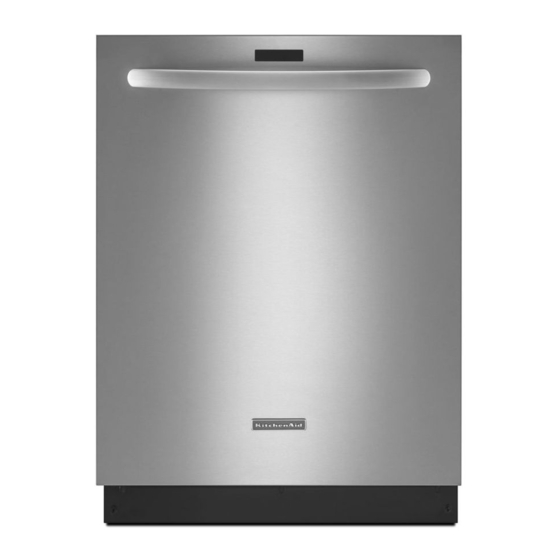KitchenAid KDTE554CSS Manual do utilizador - Página 7
Procurar online ou descarregar pdf Manual do utilizador para Máquina de lavar loiça KitchenAid KDTE554CSS. KitchenAid KDTE554CSS 17 páginas.

Scan the code at left with your mobile device, or visit https://kitchenaid.custhelp.com for recommendations
that may help you avoid a service call.
If you experience
Recommended Solutions
The Clean light is
Check the following:
flashing
Is the overfill protection float able to move up and down freely? Press down to release.
Be sure the water supply is turned on to the dishwasher. (This is very important following the new installation of your
dishwasher.)
Check for suds in the dishwasher. For more information on suds, see "Dishwasher does not clean completely."
Dishes do not dry
NOTE: Plastic and items with nonstick surfaces are difficult to dry because they have a porous surface which tends to
completely
collect water droplets. Towel drying may be necessary.
Use of rinse aid along with the Heat Dry option is needed for proper drying.
Proper loading of items can affect drying.
For improved results, place items on the more slanted side of the rack.
Glasses and cups with concave bottoms hold water. This water may spill onto other items when unloading.
Unload the bottom rack first.
Spotting/Filming
NOTES:
Liquid rinse aid is necessary for drying and to reduce spotting.
Use the correct amount of detergent.
Confirm that the cloudiness is removable by soaking the item in white vinegar for 5 minutes. If the cloudiness disappears, it
is due to hard water. Adjust the amount of detergent and rinse aid (see "Dishwasher Care" section). If it does not come
clear, it is due to etching.
Be sure the incoming water temperature is set at 120°F (49°C).
Try using the Hi-Temp Scrub or Sani Rinse options.
To remove spotting, see "Dishwasher Care" section.
Dishwasher does
Be sure the dishwasher is loaded correctly. Improper loading can greatly decrease the washing performance (see
not clean
Operating Your Dishwasher" section).
completely
Check filter to ensure it is properly installed. Clean it if needed. (See "Filtration System" in full User Guide for details.)
Select the proper cycle for the type of soils. The ProWash™ or Heavy Duty cycle can be used for tougher loads.
Be sure the incoming water temperature is at least 120°F (49°C).
Use the proper amount of fresh detergent. More detergent is needed for heavier-soiled loads and hard water conditions.
Scrape food from dishes prior to loading (do not prerinse).
If foam or suds are detected by the dishwasher sensing system, the dishwasher may not operate properly or may not fill
with water.
Suds can come from:
Using the incorrect type of detergent, such laundry detergent, hand soap, or dish detergent for hand washing dishes.
Not replacing the rinse aid dispenser cap after filling (or refilling) the rinse aid.
Using an excessive amount of dishwasher detergent.
PROBLEM SOLVER
7
